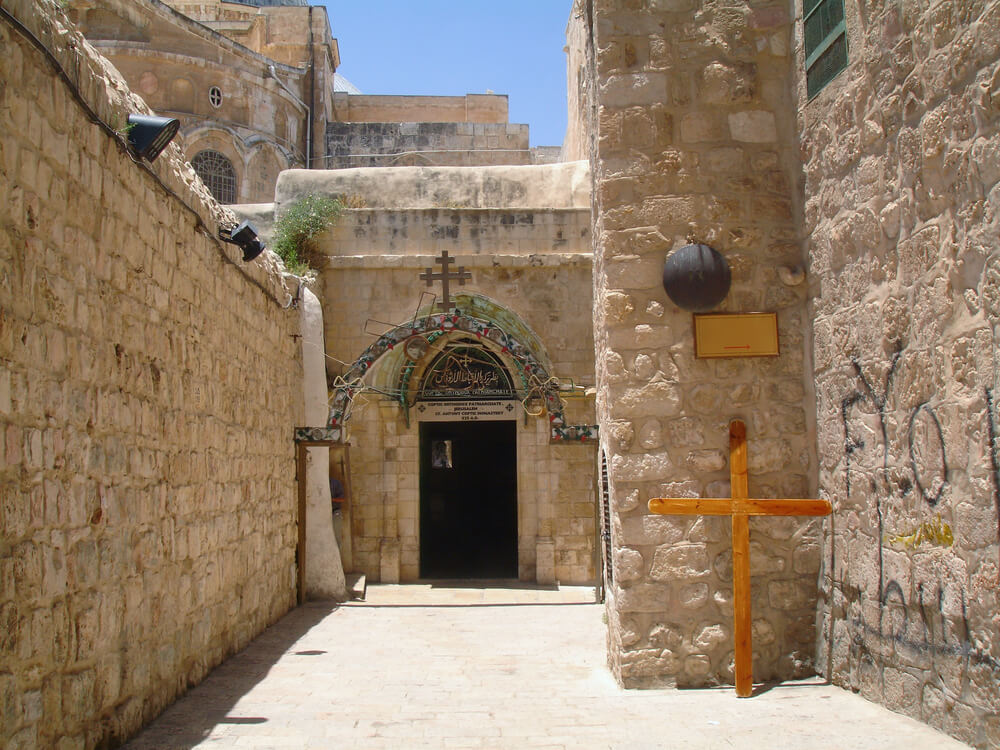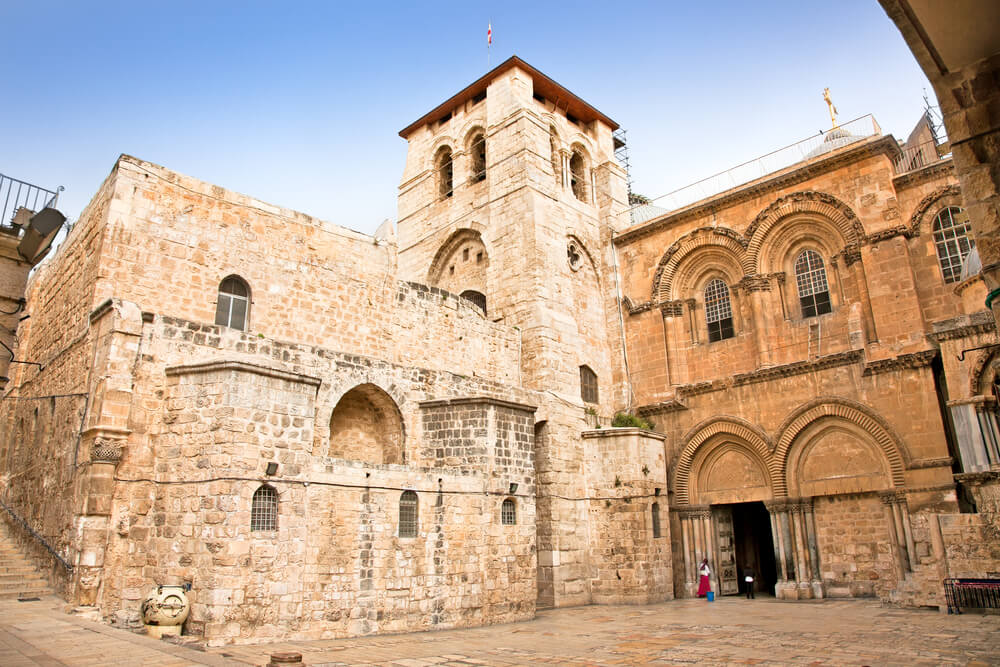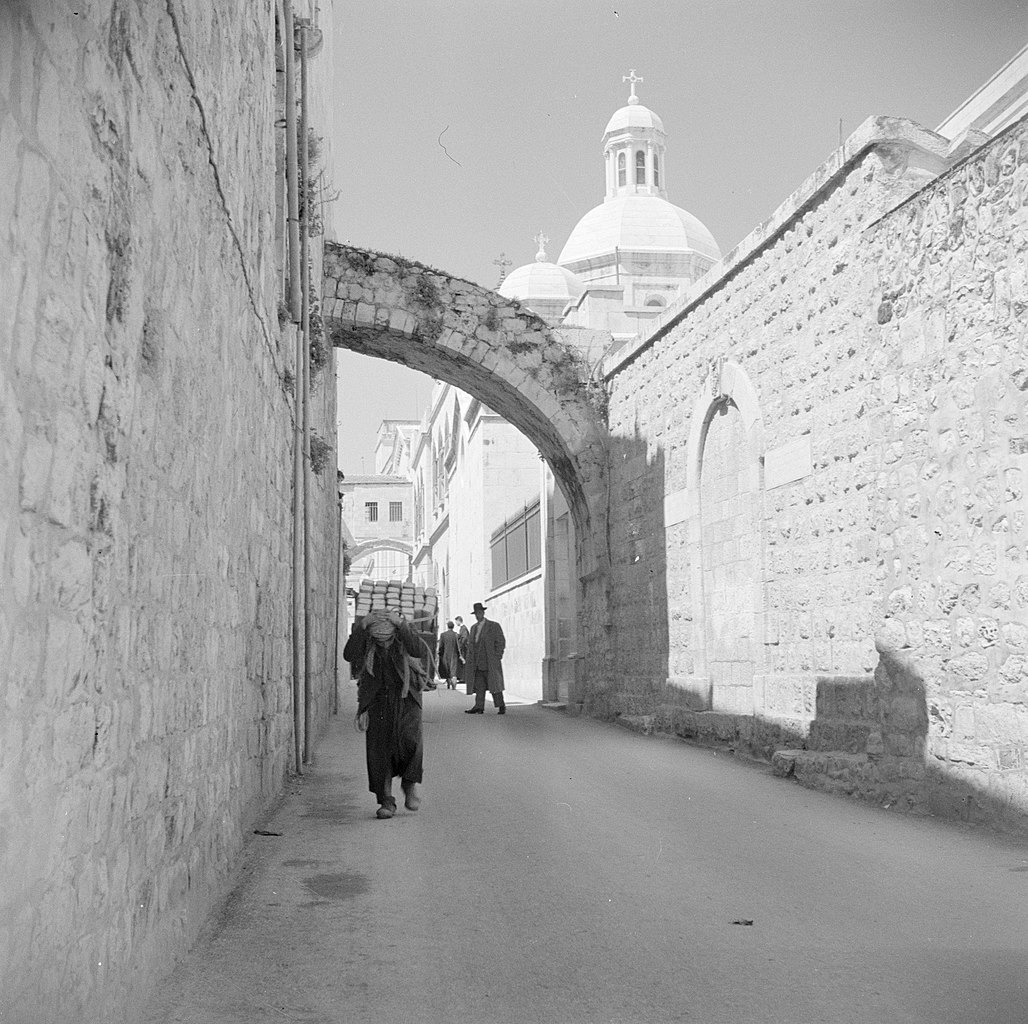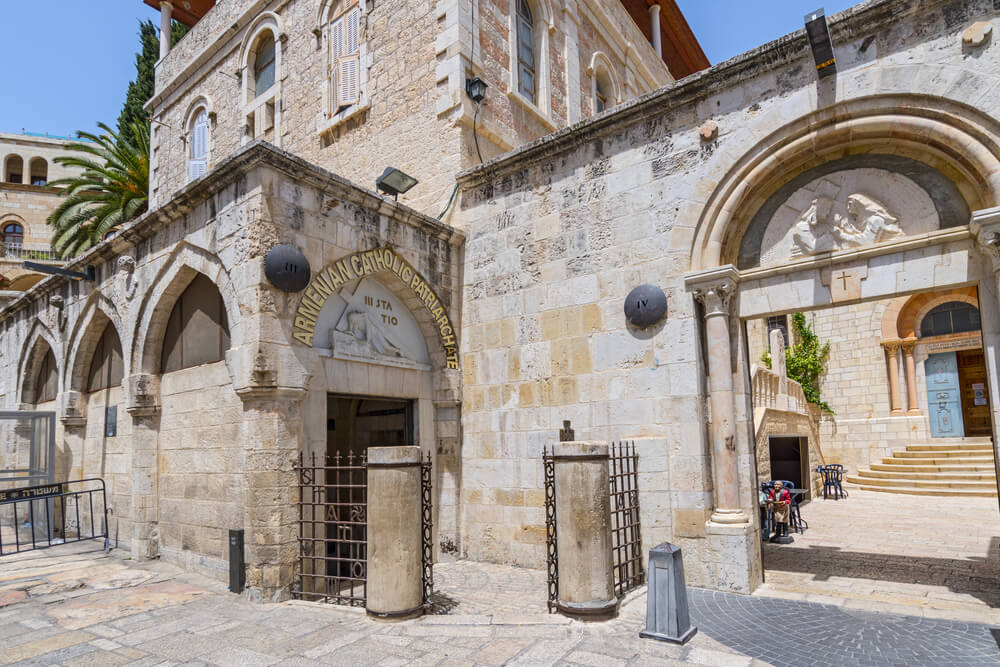Perhaps the most famous walk through the Old City of Jerusalem is along the Via Dolorosa, the Way of the Cross, or the Way of Suffering - in the footsteps of Jesus. This route stretches for 600 meters and takes you along several lanes, through street markets, past interesting eateries, and souvenir stores.
 Walking down Via Dolorosa
Walking down Via Dolorosa
But apart from being an interesting way to see the Old City, the Via Dolorosa has deep religious and historic significance. According to tradition, this is the route Jesus took bearing his cross from his trial to his crucifixion at Calvary.
Not only will you be retracing Christ’s steps, and seeing the lanes of the Old City, but you can also discover hidden gems along the way. Most people don’t know that the Via Dolorosa has several fascinating and unique chapels tucked away behind unassuming doors in the stone walls that flank the streets. And at the end of the Via Dolorosa, you’ll reach the iconic Church of the Holy Sepulchre, the most sacred Christian site in the world.
There are many Christian holy sites in Israel, and Via Dolorosa goes through several of them. It run through the Muslim Quarter and Christian Quarter of Jerusalem’s Old City. It is not one street, but rather a route that travels along several streets. The walled city has several gates where you can enter and eventually find the Via Dolorosa. But the closest gate to the start of the Via Dolorosa is Lions Gate. Stations 1-7 are in the Muslim Quarter, and the rest are in the Christian Quarter.
 Church of the Holy Sepulchre
Church of the Holy Sepulchre
Various religious bodies, archaeologists, and experts disagree about the exact starting point of the route. Some biblical scholars believe that the judgment of Jesus most likely took place outside the Antonia Palace, which no longer exists, and where the Umariya School now stands. Others suggest that it took place at Herod’s Palace near the Tower of David. It is best to look at the Via Dolorosa as an approximation of Jesus’ route and as a tradition rather than a precise map of his movements.
Via Dolorosa is not mentioned by name in the Bible but the First Testament does describe Jesus bearing his cross from his judgment before Pontius Pilot to the site of his crucifixion. The Bible describes several moments where Jesus stopped or fell as he made his way to Calvary and these moments are commemorated by the Stations of the Cross along the Via Dolorosa. But not all the stations are mentioned in the Bible. Several of the stations (3, 4, 6, 7, 9,13) are based on tradition rather than events described in the Bible.
Christian pilgrims first started following the Via Dolorosa in the Byzantine Era. It became part of the Holy Thursday procession that started on the Mount of Olives, entered the city, and proceeded to the Holy Sepulchre. The route altered several times over the next few centuries as people argued about where exactly the route started. From 1350 to 1517 Franciscan friars conducted tours of the Via Dolorosa, but in the reverse direction, starting at the Holy Sepulcher and ending at Pilate’s house.
 Via Dolorosa in 1950
Via Dolorosa in 1950
In 1517 they began walking the route in the same direction as Jesus had done. Over the next few years, the church published various guides for pilgrims which expanded on the biblical text that described Jesus’ walk to Calvary. Only then were Stations of the Cross commemorated, and the version of the route we see today was slowly formed, although there were a number of opinions about what route exactly Christ followed.
There are 14 Stations of the Cross where Jesus paused or stopped as he walked along the Via Dolorosa to Calvary. Nine stations are on the Via Dolorosa and the last five are inside the Holy Sepulchre Church. The Stations of the Cross on the Via Dolorosa are marked by a round metal plaque attached to the wall bearing the number of the station in Roman numerals. On the ground is a semi-circle of paving stones.
Located about 300m from Lions Gate, It is located inside the Madrasa al-Omariya school. Entrance to the school is only possible after 14:00, or on Friday or Saturday when the children are not at school. It is best to visit between 15:00 and 17:00. (Matthew 27, 11-14)
Located across from the first station, in the Monastery of Flagellation. Pro Tip: You can enter the monastery from 08:00-18:00 or 17:00 in winter. Enter the Chapel of the Flagellation which commemorates where the Roman guards put a crown of thorns on Jesus’ head and mocked him as the king of the Jews. Across the courtyard of the monastery compound is the Chapel of the Imposition of the Cross.
It is a modern chapel built on the remains of an earlier 11th-century church. The monastery is also home to the Terra Sancta Museum where there is a multimedia show about the Via Dolorosa and a display of archaeological findings. The museum is open Monday to Saturday 09:00-noon, and there is a small entrance fee. (Matthew 27. 27-30)
After making a sharp left onto Al-Wad Street you’ll come to the third station. This is the site of the Polish Biblical Archaeological Museum. You can enter the small Armenian church that marks this station. Above the entrance is a stone relief depicting the scene. Pro Tip: Opposite the third station is one of the few public toilets you’ll find along the route.
 Stations of the Cross number 3 and 4 in the Jerusalem Armenian Quarter
Stations of the Cross number 3 and 4 in the Jerusalem Armenian QuarterAdjacent to the third station is the place where Jesus met his mother. (Until 2008 this station was commemorated about 25 meters further down the street). See the Armenian Catholic Church of Our Lady of the Spam. Pro Tip: This church is not always open but if it is you can enter and see a Byzantine mosaic with two footprints commemorating where Mary may have stood.
The Romans picked someone out of the crowd, Simon of Cyrene, and ordered him to help Jesus who was by now beaten, tired, and near collapsing. On the wall is a handprint believed to be where Jesus leaned against the wall. The building is not 2000 years old but the piece of stone bearing the handprint is said to be from the original building. The Franciscan Chapel of Simon of Cyrene lies behind the walls, housed in the first Franciscan house in Jerusalem dating back to 1229. (Mark 13:21/Luke 23:26)
Veronica was one of Jesus’ followers, and she saw Jesus going past her house. His face was dirty and bleeding. She came out of her house and wiped his face with a piece of cloth. After he had moved on she discovered that an impression of his face had been left on the cloth. The cloth turned out to have miraculous properties and could cure anyone who touched it. Today it is in the Vatican. The Greek Catholic (Melkite) Church of Saint Veronica stands at this station. A piece of pillar is embedded in the wall of a house that bridges the street.
The chapel that marks this station is usually closed but try the door, and you might get lucky. Inside is an original column from the ancient Roman Cardo Mazimus (the main street) that once ran through Hadrian’s city called Aelia Capitolina. A 13th-century tradition holds that this was where Jesus left the city walls on his way to Calvary that would have stood outside the city at that time.
In Jesus’ lifetime, this spot would have been outside the city walls. As you approach this station you’ll pass the German hospice of Saint John where you can see a Maltese cross on the wall, and you’ll pass the Greek Convent of Saint Charalambos where the wall bears a Latin cross and the words “Jesus Christ conquers” in Greek. (Luke 23:27-31)
To get to the ninth station you need to go back from the eighth station and turn right on to Souq Khan al-Zeit. After about 100 meters on your right will be a flight of stone steps. At the top of the steps turn left along a winding lane and after about 80 meters you’ll find a Roman pillar encased in the wall of the Coptic Patriarchate. (don’t worry there are clear signs and crowds of tourists all going in the same direction). The area is a Coptic compound and is on the roof of the Church of the Holy Sepulchre. You will also see where a community of Ethiopian Christians has taken up residence on the rooftop. Pro Tip: At the end of the street to the right is an entrance that will lead you down to the Helene Cistern. It is a real hidden gem, seeped in legends. From here there is a passageway to the courtyard in front of the Church of the Holy Sepulchre.
The Stations of the Cross that are inside the church are not marked by plaques but they include the 10th station where Jesus was undressed; the 11th station where Jesus was placed on the cross; the 12th station where Jesus died on the cross; the 13th station where Jewsis was taken down off the cross, and the 14th station where he was placed in the tomb.
Tours You May Like